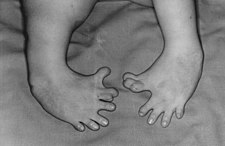Fokomelie
| Fokomelie | |
|---|---|
 | |
| Klasifikace | |
| MKN-10 | Q73.1 |
| MeSH | D004480 |
| Některá data mohou pocházet z datové položky. | |
Fokomelie (z řeckého φώκη = „tuleň“ a μέλος = „končetina“)[1] patří mezi atrofické vrozené vady horní (někdy dolní) končetiny.
Fokomelie byla jednou z typických součástí tzv. fetálního thalidomidového syndromu (na přelomu 60. let 20. století se po celém světě narodilo až okolo 6000 dětí s různými malformacemi, způsobenými teratogenním působením thalidomidu).[2]
Definice
Kompletní podélný defekt na horní končetině: kosti pažní (humerus), vřetenní (radius), loketní (ulna), eventuálně zápěstí a na dolní končetině: kosti stehenní (os femoris), holenní (tibia), lýtkové (fibula), eventuálně nártu. Na horní končetině nasedá víceméně normální ruka přímo na pletenec ramenní, na dolní končetině noha na pletenec pánevní.[3]
Léčba
Jedinci postižení fokomelií horních končetin používali k sebeobsluze převážně zachovalých dolních končetin. V současnosti je tento defekt řešen tahovými/elektrickými protézami, ovládanými fokomelickou rukou. Fokomelie dolních končetin se ošetřuje proteticky jako oboustranná exartikulace (amputace v kloubu) v kyčelním kloubu.[3]
Odkazy
Reference
V tomto článku je použit text článku Fokomelie ve WikiSkriptech českých a slovenských lékařských fakult zapojených v MEFANETu.
- ↑ Definition of Phocomelia [online]. MedicineNet [cit. 2009-09-27]. Dostupné v archivu pořízeném dne 2011-08-11. (anglicky)
- ↑ KALTER, H. Teratology in the Twentieth Century. Congenital Malformations in Humans and how their Environmental Causes were Established. Amsterdam: Elsevier, 2003. ISBN 978-0-444-51364-9. S. 166. (anglicky)
- ↑ a b SOSNA, A.; VAVŘÍK, P.; KRBEC, M.; POKORNÝ, D. Základy ortopedie. 1. vyd. Praha: Triton, 2001. ISBN 80-7254-202-8.
Externí odkazy
 Obrázky, zvuky či videa k tématu fokomelie na Wikimedia Commons
Obrázky, zvuky či videa k tématu fokomelie na Wikimedia Commons

Přečtěte si prosím pokyny pro využití článků o zdravotnictví.
Média použitá na této stránce
Star of life, blue version. Represents the Rod of Asclepius, with a snake around it, on a 6-branch star shaped as the cross of 3 thick 3:1 rectangles.
Design:
The logo is basically unicolor, most often a slate or medium blue, but this design uses a slightly lighter shade of blue for the outer outline of the cross, and the outlines of the rod and of the snake. The background is transparent (but the star includes a small inner plain white outline). This makes this image usable and visible on any background, including blue. The light shade of color for the outlines makes the form more visible at smaller resolutions, so that the image can easily be used as an icon.
This SVG file was manually created to specify alignments, to use only integers at the core 192x192 size, to get smooth curves on connection points (without any angle), to make a perfect logo centered in a exact square, to use a more precise geometry for the star and to use slate blue color with slightly lighter outlines on the cross, the rod and snake.
Finally, the SVG file is clean and contains no unnecessary XML elements or attributes, CSS styles or transforms that are usually added silently by common SVG editors (like Sodipodi or Inkscape) and that just pollute the final document, so it just needs the core SVG elements for the rendering. This is why its file size is so small.Autor: Not specified at the source. Uploaded to flickr by Otis Historical Archives National Museum of Health and Medicine., Licence: CC BY 2.0
Congenital malformation of the feet. Effects of maternal drugs - thalidomide. Selected by Tom.

